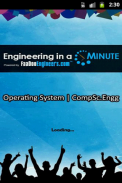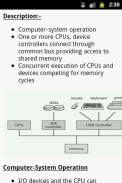






Operating System - OS

توضیحات Operating System - OS
Welcome to an exciting world of operating system (O/S). The Basics of Operating System is a free app with listing of notes on the introduction of the OS and covers the basics of how system software works
Usually a part of computer science, software engineering, programming and information technology courses but open for all enthusiasts to learn the basics.
The App covers more than 125 topics on the subject divided into 14 units.
The App brings all the interesting topics in a flashcard which is easy to browse, revise and come back to another topic to learn. Some of topics Covered in this application are:
1. Overview of computer operating systems
2. Computer System Organization
3. Operating System Structure
4. Distributed system
5. Operating System services
6. System Calls
7. System Programs
8. Operating System Generation
9. Operating-System Services
10. Operating-System Interface
11. Process Management
12. Process Control Block
13. Schedulers
14. Context switch
15. Operations on Processes
16. Interprocess Communication
17. Sockets
18. Remote Procedure Calls
19. Remote method invocation
20. Threads
21. Scheduling Criteria
22. Scheduling Algorithms
23. Multithreading Models
24. Thread Libraries
25. Threading Issues
26. CPU scheduling
27. Multiple-Processor Scheduling
28. Symmetric Multithreading
29. Thread Scheduling
30. Solaris Scheduling
31. Windows XP Scheduling
32. Linux Scheduling
33. Algorithm Evaluation
34. Process Synchronization
35. The Critical Section Problem
36. Synchronization Hardware
37. Semaphores
38. Classic problems of synchronization
39. Monitors
40. Atomic Transactions
41. Deadlocks
42. Deadlock Characterization
43. Methods for handling deadlocks
44. Deadlock Prevention
45. Deadlock Avoidance
46. Banker’s algorithm
47. Deadlock Detection
48. Recovery from Deadlock
49. Memory Management Strategies
50. Address Binding
51. Logical versus Physical Address Space
52. Dynamic Linking and Loading
53. Swapping
54. Contiguous Memory Allocation
55. Fragmentation
56. Paging
57. Hardware Support in paging
58. Shared Pages
59. Segmentation
60. Virtual memory
61. System libraries
62. Demand Paging
63. Copy-on-Write
64. Page Replacement
65. FIFO Page Replacement
66. Optimal Page Replacement
67. LRU Page Replacement
68. Enhanced Second-Chance Algorithm
69. Allocation of Frames
70. Thrashing
71. Working-Set Model
72. Page-Fault Frequency
73. Memory-Mapped Files
74. Shared Memory in the Win32 API
75. Allocating Kernel Memory
76. Slab Allocation
77. File Concept
78. File Operations
79. File Types
80. Directory Structure
81. Directory
82. File System Mounting
83. File System Structure
84. File System Implementation
85. Directory Implementation
86. Free Space Management
87. Recovery
88. Log-Structured File Systems
89. Network file systems
90. Network file systems protocol
91. Magnetic Disks
92. Disk Structure
93. Disk Attachment
94. Disk Scheduling
95. Disk Management
96. Boot Block
97. Bad Blocks
98. Swap-Space Management
99. I/O Systems
100. Polling
101. Direct Memory Access
102. Application I/O Interface
103. Kernel I/O Subsystem
104. Transforming I/O Requests to Hardware Operations
105. Streams
106. Performance
107. Protection
108. Access Matrix
109. Implementation of Access Matrix
110. Access Control
111. Language-Based Protection
112. The Security Problem
113. Malicious codes
114. System and Network Threats
115. Cryptography as a Security Tool
116. Authentication
117. Key Distribution
118. User Authentication
119. Firewalling to Protect Systems and Networks
IMPORTANT LINKS
Feedback: Share your feedback at essyengineering@gmail.com
Social links
Facebook : https://www.facebook.com/EngineeringEasy/
Twitter : https://twitter.com/easyengineerin
Website:http://www.engineeringapps.net/
Wishing you a very happy learning
</div> <div jsname="WJz9Hc" style="display:none">Welkom op een spannende wereld van het besturingssysteem (O / S). De basisprincipes van het Operating System is een gratis app met vermelding van nota's over de invoering van het OS en heeft betrekking op de basis van hoe het systeem software werkt
Meestal wordt een deel van de informatica, software engineering, programmeren en informatietechnologie cursussen, maar open voor alle liefhebbers om de basis te leren.
De App omvat meer dan 125 onderwerpen over het onderwerp verdeeld in 14 eenheden.
De App brengt alle interessante onderwerpen in een flashcard die gemakkelijk te doorbladeren, herzien en terug te komen op een ander onderwerp te leren. Sommige van de onderwerpen die in deze toepassing zijn:
1. Overzicht van besturingssystemen
2. Computer System Organization
3. Operating System Structuur
4. gedistribueerd systeem
5. Operating System diensten
6. Systeem Gesprekken
7. Systeem Programma's
8. Besturingssysteem Generation
9. Operating-System Services
10. Operating-System Interface
11. Process Management
12. Process Control Block
13. planners
14. Context switch
15. Bewerkingen op Processen
16. interprocescommunicatie
17. Sockets
18. Remote Procedure Calls
19. Remote Method Invocation
20. Threads
21. Scheduling Criteria
22. planningalgoritmen
23. Multithreading Models
24. Thread Bibliotheken
25. Threading Issues
26. CPU scheduling
27. Multiple-Processor Scheduling
28. Symmetric Multithreading
29. Thread Scheduling
30. Solaris Scheduling
31. Windows XP Scheduling
32. Linux Scheduling
33. Algoritme Evaluatie
34. Proces Synchronisatie
35. De kritieke sectie probleem
36. Synchronisatie Hardware
37. Semaforen
38. Classic problemen van de synchronisatie
39. Monitors
40. Atomic Transacties
41. Impasses
42. Deadlock karakterisering
43. Methoden voor de behandeling impasses
44. Deadlock Prevention
45. Deadlock Avoidance
46. Banker ¢ â,¬â "¢ s algoritme
47. Deadlock Detection
48. Herstel van Deadlock
49. Memory Management Strategies
50. Adres Binding
51. Logische versus Physical Address Space
52. Dynamic Linking and Loading
53. Swapping
54. Aangrenzend Geheugentoewijzing
55. Fragmentatie
56. Paging
57. Hardware Ondersteuning bij paging
58. Gedeelde pagina's
59. Segmentatie
60. Virtueel geheugen
61. Systeem bibliotheken
62. de vraag paging
63. Copy-on-Write
64. Pagina Vervanging
65. FIFO Pagina Replacement
66. Optimale Pagina Replacement
67. LRU Pagina Replacement
68. Enhanced Second Chance-algoritme
69. Toewijzing van Frames
70. Thrashing
71. Werken-Set Model
72. Page-Fault Frequency
73. Memory-toegewezen bestanden
74. Shared Memory in de Win32 API
75. toewijzen Kernel Memory
76. Slab Allocation
77. File Concept
78. File Operations
79. Bestandstypen
80. Mappenstructuur
81. Directory
82. File System Montage
83. File System Structure
84. File System Implementatie
85. Directory Implementatie
86. Gratis Space Management
87. Recovery
88.-Log Gestructureerde File Systems
89. Netwerk bestandssystemen
90. Netwerk bestandssystemen protocol
91. Magnetische Schijven
92. Disk Structuur
93. Disk Attachment
94. Disk Scheduling
95. Schijfbeheer
96. Boot Block
97. Bad Blocks
98. Swap-Space Management
99. I / O Systemen
100. Polling
101. Direct Memory Access
102. Application I / O-interface
103. Kernel I / O subsysteem
104. Transforming I / O-verzoeken om Hardware Operations
105. Streams
106. Prestaties
107. Bescherming
108. Toegang Matrix
109. Implementatie van Access Matrix
110. Access Control
111.-Taal gebaseerde bescherming
112. The Security Problem
113. Schadelijke codes
114. System and Network Bedreigingen
115. Cryptografie als een Security Tool
116. Authenticatie
117. Key Distribution
118. Gebruikersauthenticatie
119. Firewalling systemen en netwerken te beveiligen
BELANGRIJKE LINKS
Feedback: Deel je feedback op essyengineering@gmail.com
sociale banden
Facebook: https://www.facebook.com/EngineeringEasy/
Twitter: https://twitter.com/easyengineerin
Website: http: //www.engineeringapps.net/
Ik wens u een heel gelukkig learning</div> <div class="show-more-end">

























